Abstract
1. Acetylcholine (ACh) and the M1 agonists (McN-A-343 or PD142505) relaxed human isolated pulmonary arteries which were pre-contracted with noradrenaline (10 microM). In preparations where the endothelium had been removed ACh induced a contractile response whereas the M1 agonists (McN-A-343 or PD142505) had no effect. 2. ACh- and McN-A-343-induced relaxations were abolished after treatment of endothelium-intact preparations with the drug combination NG-nitro-L-arginine (L-NOARG: 0.1 mM) and indomethacin (1.7 microM). 3. The affinity (pKB value) for pirenzepine was higher in human pulmonary arteries when tissues were relaxed with McN-A-343 as compared with ACh (pKB values, 7.71 +/- 0.30 (n = 4) and 6.68 +/- 0.15 (n = 8), respectively). In addition, the affinity for pFHHSiD against McN-A-343- and ACh-induced relaxations was 6.86 +/- 0.13 (n = 3) and 7.35 +/- 0.11 (n = 9) respectively. 4. The low affinities for methoctramine in human isolated pulmonary arteries with the endothelium either intact or removed, suggested the lack of involvement of M2 and M4 receptors in the Ach responses. 5. Phenoxybenzamine (3 microM: 30 min) abolished both ACh contraction and relaxation in human pulmonary artery. The ACh contraction was present when the phenoxybenzamine treatment was preceded by incubation with pFHHSiD (2 microM) but not with pirenzepine (1 microM). In addition, the ACh relaxation was present when preparations were treated with either pFHHSiD (2 microM) or pirenzepine (1 microM), before exposure to phenoxybenzamine. 6. These results in human isolated pulmonary arteries support the notion that only M3 receptors, on smooth muscle, mediate the ACh-induced contraction whereas M3 and M1 receptors are involved in the endothelium-dependent ACh-induced relaxation.
Full text
PDF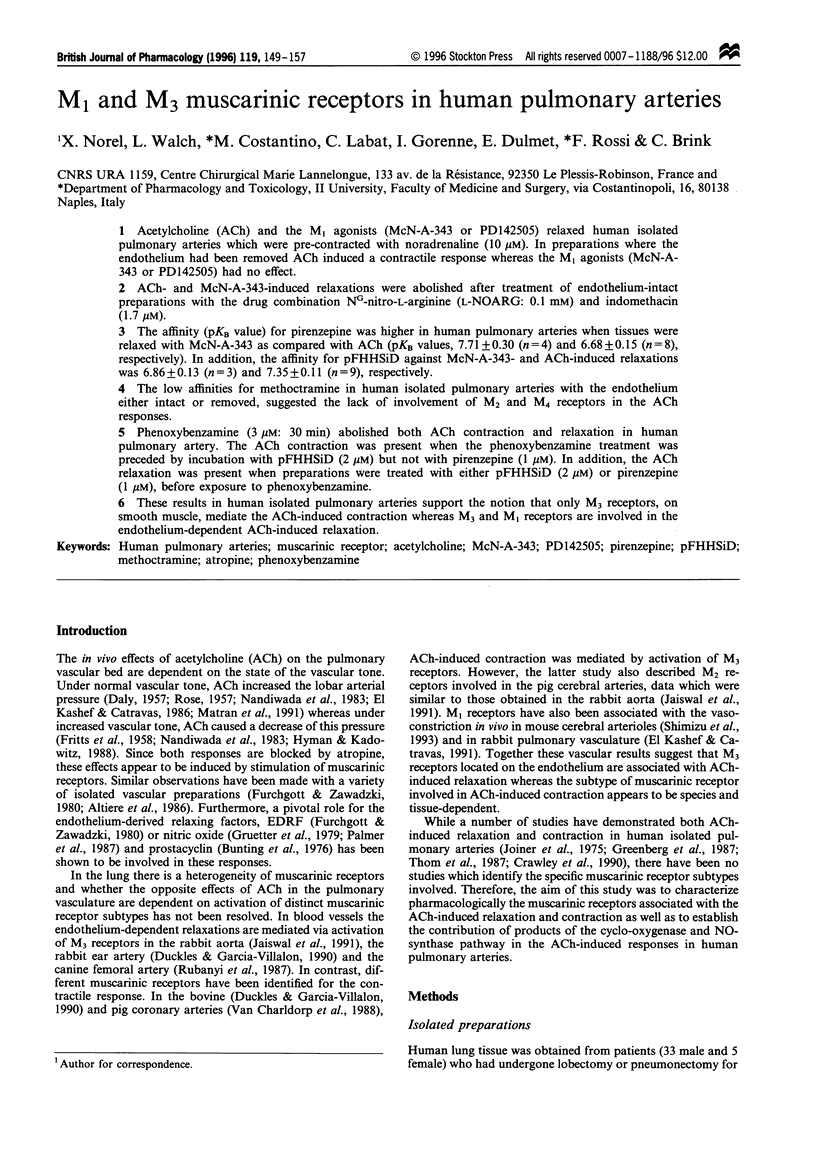
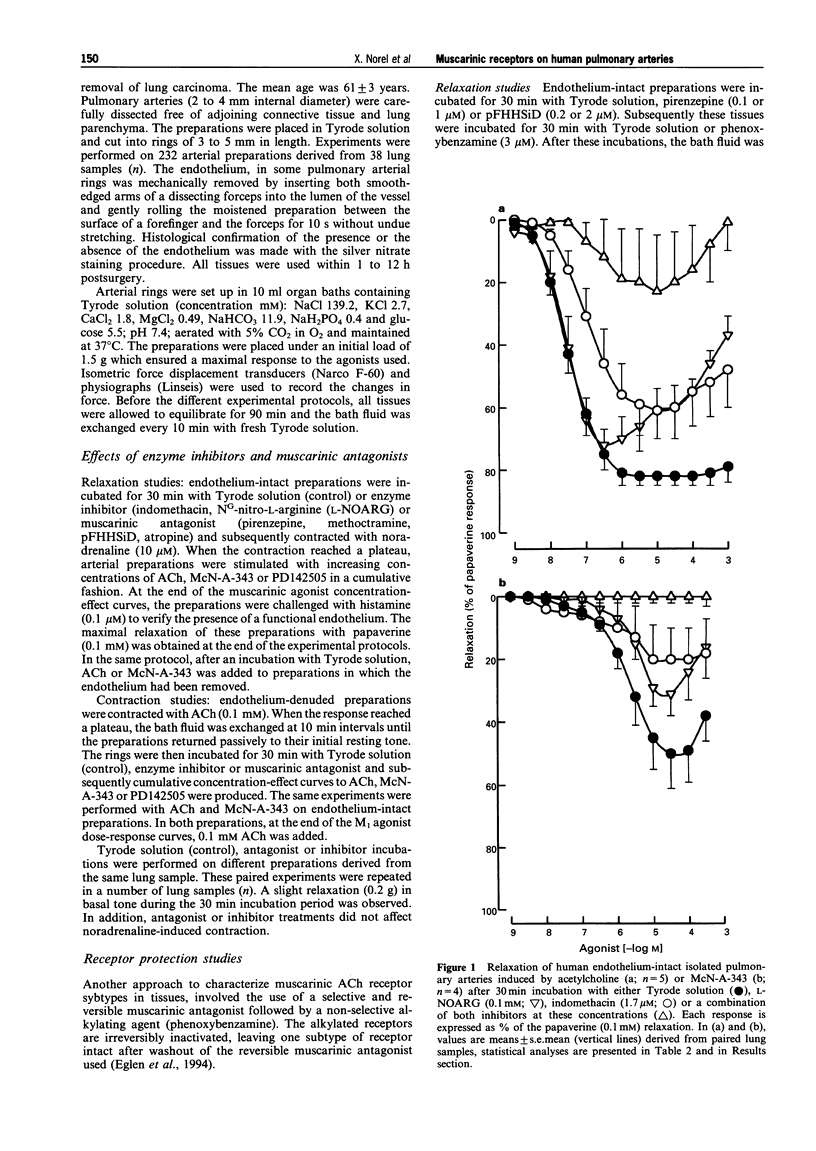
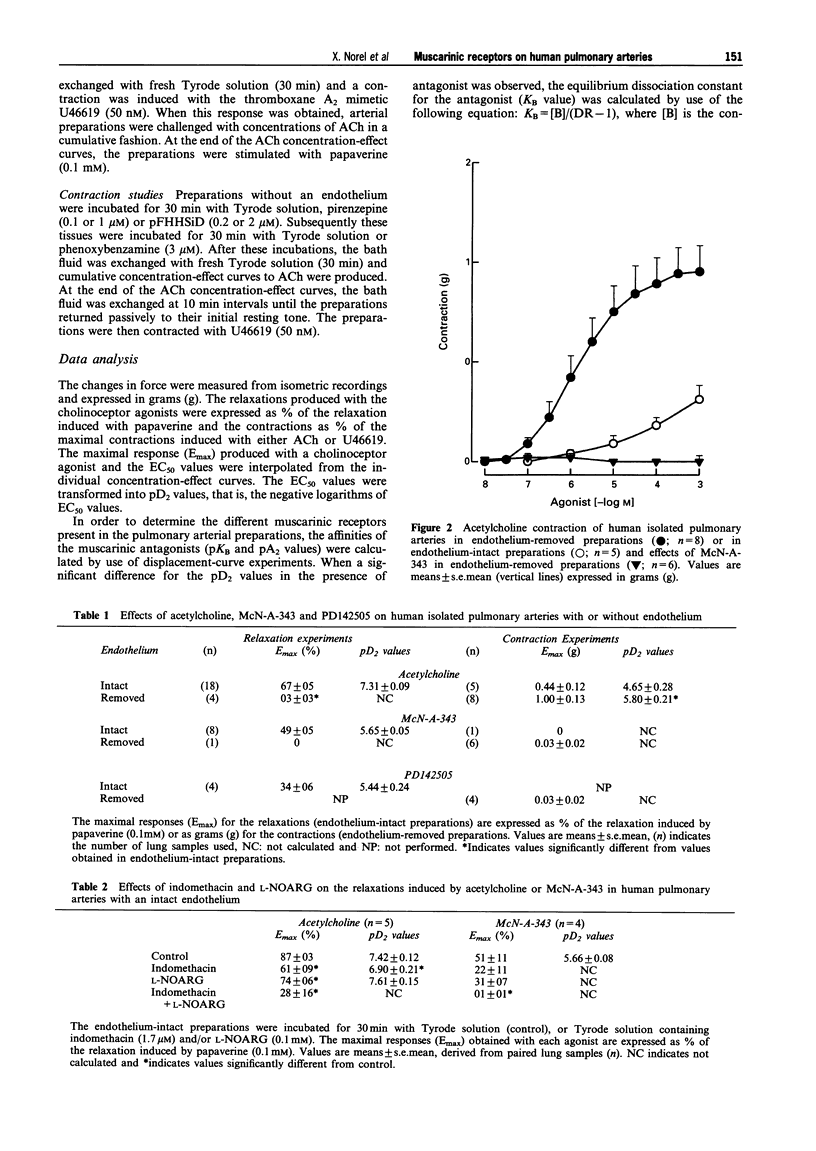

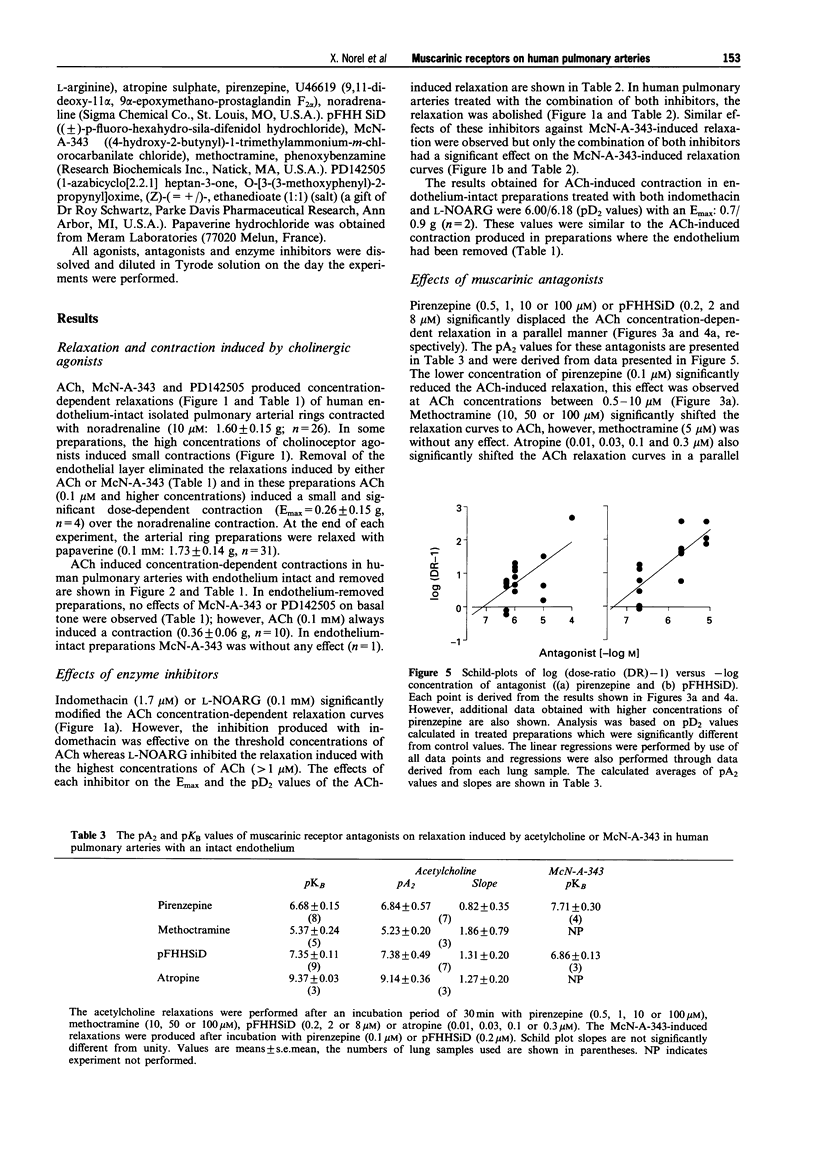
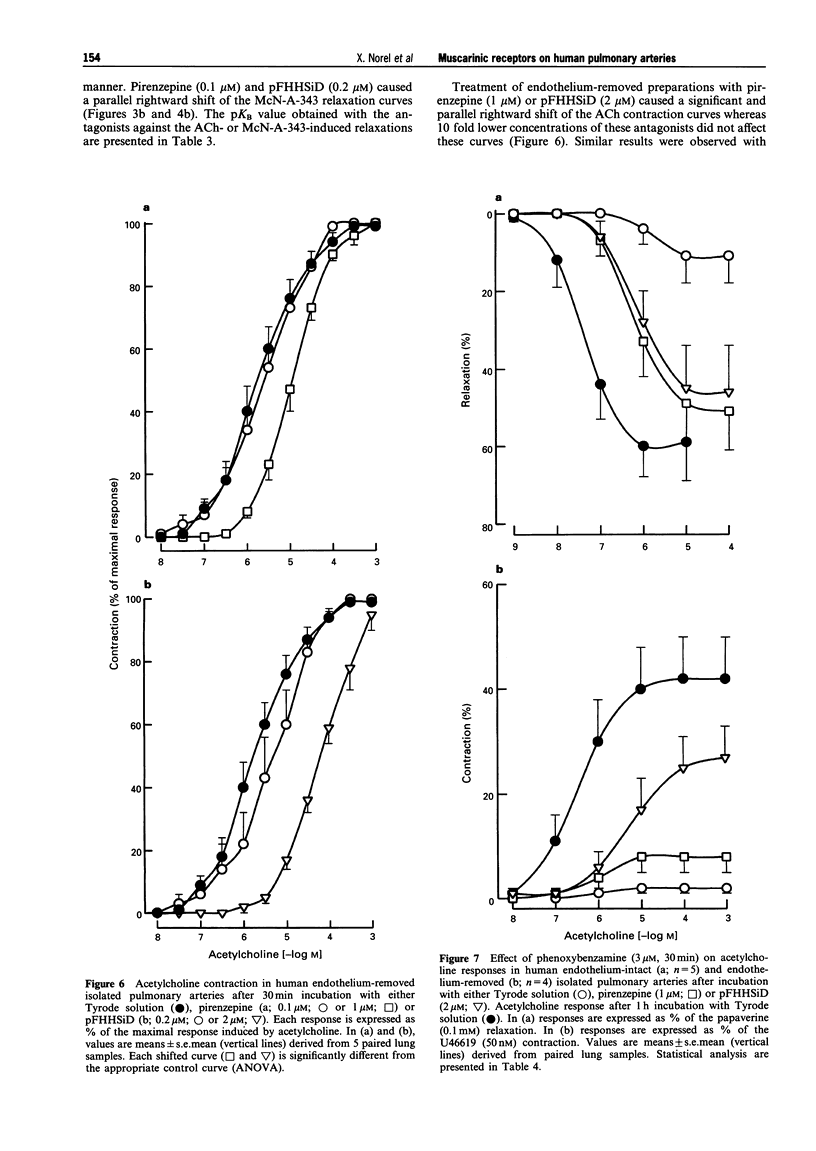
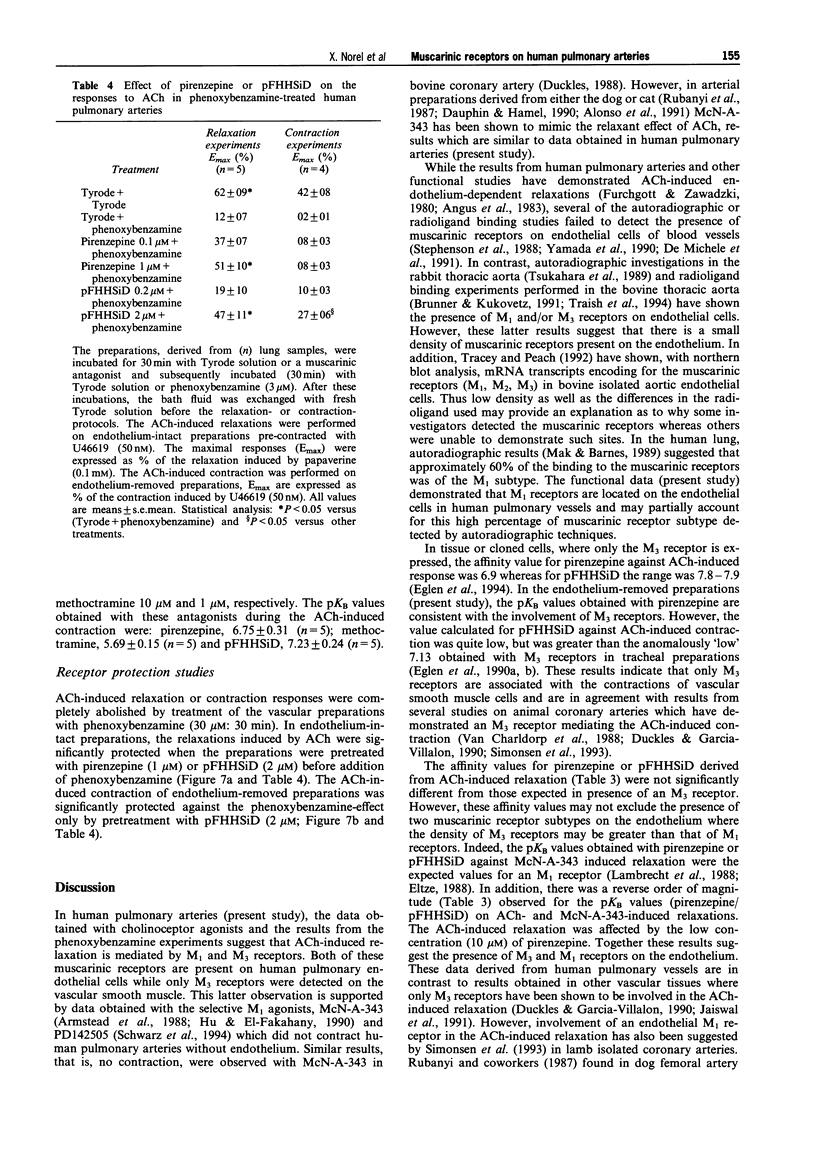
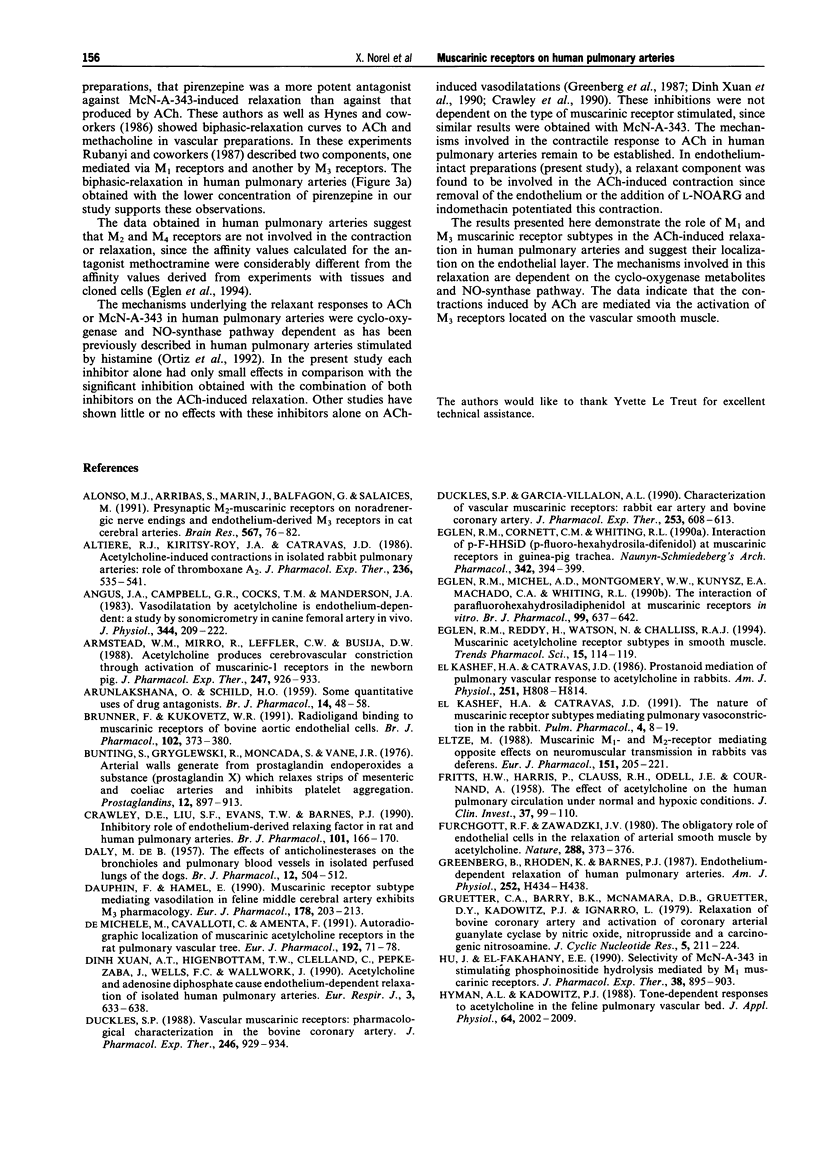

Selected References
These references are in PubMed. This may not be the complete list of references from this article.
- ARUNLAKSHANA O., SCHILD H. O. Some quantitative uses of drug antagonists. Br J Pharmacol Chemother. 1959 Mar;14(1):48–58. doi: 10.1111/j.1476-5381.1959.tb00928.x. [DOI] [PMC free article] [PubMed] [Google Scholar]
- Alonso M. J., Arribas S., Marín J., Balfagón G., Salaices M. Presynaptic M2-muscarinic receptors on noradrenergic nerve endings and endothelium-derived M3 receptors in cat cerebral arteries. Brain Res. 1991 Dec 13;567(1):76–82. doi: 10.1016/0006-8993(91)91438-7. [DOI] [PubMed] [Google Scholar]
- Altiere R. J., Kiritsy-Roy J. A., Catravas J. D. Acetylcholine-induced contractions in isolated rabbit pulmonary arteries: role of thromboxane A2. J Pharmacol Exp Ther. 1986 Feb;236(2):535–541. [PubMed] [Google Scholar]
- Angus J. A., Campbell G. R., Cocks T. M., Manderson J. A. Vasodilatation by acetylcholine is endothelium-dependent: a study by sonomicrometry in canine femoral artery in vivo. J Physiol. 1983 Nov;344:209–222. doi: 10.1113/jphysiol.1983.sp014934. [DOI] [PMC free article] [PubMed] [Google Scholar]
- Armstead W. M., Mirro R., Leffler C. W., Busija D. W. Acetylcholine produces cerebrovascular constriction through activation of muscarinic-1 receptors in the newborn pig. J Pharmacol Exp Ther. 1988 Dec;247(3):926–933. [PubMed] [Google Scholar]
- Brunner F., Kukovetz W. R. Radioligand binding to muscarinic receptors of bovine aortic endothelial cells. Br J Pharmacol. 1991 Feb;102(2):373–380. doi: 10.1111/j.1476-5381.1991.tb12181.x. [DOI] [PMC free article] [PubMed] [Google Scholar]
- Bunting S., Gryglewski R., Moncada S., Vane J. R. Arterial walls generate from prostaglandin endoperoxides a substance (prostaglandin X) which relaxes strips of mesenteric and coeliac ateries and inhibits platelet aggregation. Prostaglandins. 1976 Dec;12(6):897–913. doi: 10.1016/0090-6980(76)90125-8. [DOI] [PubMed] [Google Scholar]
- Crawley D. E., Liu S. F., Evans T. W., Barnes P. J. Inhibitory role of endothelium-derived relaxing factor in rat and human pulmonary arteries. Br J Pharmacol. 1990 Sep;101(1):166–170. doi: 10.1111/j.1476-5381.1990.tb12107.x. [DOI] [PMC free article] [PubMed] [Google Scholar]
- DE BURGH DALY M. The effects of anticholinesterases on the bronchioles and pulmonary blood vessels in isolated perfused lungs of the dog. Br J Pharmacol Chemother. 1957 Dec;12(4):504–512. doi: 10.1111/j.1476-5381.1957.tb00173.x. [DOI] [PMC free article] [PubMed] [Google Scholar]
- Dauphin F., Hamel E. Muscarinic receptor subtype mediating vasodilation feline middle cerebral artery exhibits M3 pharmacology. Eur J Pharmacol. 1990 Mar 20;178(2):203–213. doi: 10.1016/0014-2999(90)90476-m. [DOI] [PubMed] [Google Scholar]
- De Michele M., Cavallotti C., Amenta F. Autoradiographic localization of muscarinic acetylcholine receptors in the rat pulmonary vascular tree. Eur J Pharmacol. 1991 Jan 3;192(1):71–78. doi: 10.1016/0014-2999(91)90070-7. [DOI] [PubMed] [Google Scholar]
- Dinh Xuan A. T., Higenbottam T. W., Clelland C., Pepke-Zaba J., Wells F. C., Wallwork J. Acetylcholine and adenosine diphosphate cause endothelium-dependent relaxation of isolated human pulmonary arteries. Eur Respir J. 1990 Jun;3(6):633–638. [PubMed] [Google Scholar]
- Duckles S. P., Garcia-Villalon A. L. Characterization of vascular muscarinic receptors: rabbit ear artery and bovine coronary artery. J Pharmacol Exp Ther. 1990 May;253(2):608–613. [PubMed] [Google Scholar]
- Duckles S. P. Vascular muscarinic receptors: pharmacological characterization in the bovine coronary artery. J Pharmacol Exp Ther. 1988 Sep;246(3):929–934. [PubMed] [Google Scholar]
- Eglen R. M., Cornett C. M., Whiting R. L. Interaction of p-F-HHSiD (p-Fluoro-hexahydrosila-difenidol) at muscarinic receptors in guinea-pig trachea. Naunyn Schmiedebergs Arch Pharmacol. 1990 Oct;342(4):394–399. doi: 10.1007/BF00169455. [DOI] [PubMed] [Google Scholar]
- Eglen R. M., Michel A. D., Montgomery W. W., Kunysz E. A., Machado C. A., Whiting R. L. The interaction of parafluorohexahydrosiladiphenidol at muscarinic receptors in vitro. Br J Pharmacol. 1990 Apr;99(4):637–642. doi: 10.1111/j.1476-5381.1990.tb12983.x. [DOI] [PMC free article] [PubMed] [Google Scholar]
- Eglen R. M., Reddy H., Watson N., Challiss R. A. Muscarinic acetylcholine receptor subtypes in smooth muscle. Trends Pharmacol Sci. 1994 Apr;15(4):114–119. doi: 10.1016/0165-6147(94)90047-7. [DOI] [PubMed] [Google Scholar]
- Eltze M. Muscarinic M1- and M2-receptors mediating opposite effects on neuromuscular transmission in rabbit vas deferens. Eur J Pharmacol. 1988 Jul 7;151(2):205–221. doi: 10.1016/0014-2999(88)90801-1. [DOI] [PubMed] [Google Scholar]
- Furchgott R. F., Zawadzki J. V. The obligatory role of endothelial cells in the relaxation of arterial smooth muscle by acetylcholine. Nature. 1980 Nov 27;288(5789):373–376. doi: 10.1038/288373a0. [DOI] [PubMed] [Google Scholar]
- Greenberg B., Rhoden K., Barnes P. J. Endothelium-dependent relaxation of human pulmonary arteries. Am J Physiol. 1987 Feb;252(2 Pt 2):H434–H438. doi: 10.1152/ajpheart.1987.252.2.H434. [DOI] [PubMed] [Google Scholar]
- Gruetter C. A., Barry B. K., McNamara D. B., Gruetter D. Y., Kadowitz P. J., Ignarro L. Relaxation of bovine coronary artery and activation of coronary arterial guanylate cyclase by nitric oxide, nitroprusside and a carcinogenic nitrosoamine. J Cyclic Nucleotide Res. 1979;5(3):211–224. [PubMed] [Google Scholar]
- Hu J. R., el-Fakahany E. E. Selectivity of McN-A-343 in stimulating phosphoinositide hydrolysis mediated by M1 muscarinic receptors. Mol Pharmacol. 1990 Dec;38(6):895–903. [PubMed] [Google Scholar]
- Hyman A. L., Kadowitz P. J. Tone-dependent responses to acetylcholine in the feline pulmonary vascular bed. J Appl Physiol (1985) 1988 May;64(5):2002–2009. doi: 10.1152/jappl.1988.64.5.2002. [DOI] [PubMed] [Google Scholar]
- Hynes M. R., Banner W., Jr, Yamamura H. I., Duckles S. P. Characterization of muscarinic receptors of the rabbit ear artery smooth muscle and endothelium. J Pharmacol Exp Ther. 1986 Jul;238(1):100–105. [PubMed] [Google Scholar]
- Jaiswal N., Lambrecht G., Mutschler E., Tacke R., Malik K. U. Pharmacological characterization of the vascular muscarinic receptors mediating relaxation and contraction in rabbit aorta. J Pharmacol Exp Ther. 1991 Sep;258(3):842–850. [PubMed] [Google Scholar]
- Joiner P. D., Kadowitz P. J., Hughes J. P., Hyman A. L. NE and ACh responses of intrapulmonary vessels from dog, swine, sheep, and man. Am J Physiol. 1975 Jun;228(6):1821–1827. doi: 10.1152/ajplegacy.1975.228.6.1821. [DOI] [PubMed] [Google Scholar]
- Lambrecht G., Feifel R., Forth B., Strohmann C., Tacke R., Mutschler E. p-fluoro-hexahydro-sila-difenidol: the first M2 beta-selective muscarinic antagonist. Eur J Pharmacol. 1988 Jul 26;152(1-2):193–194. doi: 10.1016/0014-2999(88)90856-4. [DOI] [PubMed] [Google Scholar]
- Mak J. C., Barnes P. J. Muscarinic receptor subtypes in human and guinea pig lung. Eur J Pharmacol. 1989 May 19;164(2):223–230. doi: 10.1016/0014-2999(89)90462-7. [DOI] [PubMed] [Google Scholar]
- Matran R., Alving K., Lundberg J. M. Differential bronchial and pulmonary vascular responses to vagal stimulation in the pig. Acta Physiol Scand. 1991 Dec;143(4):387–393. doi: 10.1111/j.1748-1716.1991.tb09250.x. [DOI] [PubMed] [Google Scholar]
- Nandiwada P. A., Hyman A. L., Kadowitz P. J. Pulmonary vasodilator responses to vagal stimulation and acetylcholine in the cat. Circ Res. 1983 Jul;53(1):86–95. doi: 10.1161/01.res.53.1.86. [DOI] [PubMed] [Google Scholar]
- Ortiz J. L., Labat C., Norel X., Gorenne I., Verley J., Brink C. Histamine receptors on human isolated pulmonary arterial muscle preparations: effects of endothelial cell removal and nitric oxide inhibitors. J Pharmacol Exp Ther. 1992 Feb;260(2):762–767. [PubMed] [Google Scholar]
- Palmer R. M., Ferrige A. G., Moncada S. Nitric oxide release accounts for the biological activity of endothelium-derived relaxing factor. Nature. 1987 Jun 11;327(6122):524–526. doi: 10.1038/327524a0. [DOI] [PubMed] [Google Scholar]
- ROSE J. C. Active constriction and dilatation in pulmonary circulation in response to acetylcholine. Proc Soc Exp Biol Med. 1957 Apr;94(4):734–737. doi: 10.3181/00379727-94-23069. [DOI] [PubMed] [Google Scholar]
- Rubanyi G. M., McKinney M., Vanhoutte P. M. Biphasic release of endothelium-derived relaxing factor(s) by acetylcholine from perfused canine femoral arteries. Characterization of muscarinic receptors. J Pharmacol Exp Ther. 1987 Mar;240(3):802–808. [PubMed] [Google Scholar]
- Simonsen U., Prieto D., Rivera L., Hernández M., Mulvany M. J., García-Sacristán A. Heterogeneity of muscarinic receptors in lamb isolated coronary resistance arteries. Br J Pharmacol. 1993 Aug;109(4):998–1007. doi: 10.1111/j.1476-5381.1993.tb13720.x. [DOI] [PMC free article] [PubMed] [Google Scholar]
- Stephenson J. A., Gibson R. E., Summers R. J. An autoradiographic study of muscarinic cholinoceptors in blood vessels: no localization on vascular endothelium. Eur J Pharmacol. 1988 Aug 24;153(2-3):271–283. doi: 10.1016/0014-2999(88)90615-2. [DOI] [PubMed] [Google Scholar]
- Thom S., Hughes A., Martin G., Sever P. S. Endothelium-dependent relaxation in isolated human arteries and veins. Clin Sci (Lond) 1987 Nov;73(5):547–552. doi: 10.1042/cs0730547. [DOI] [PubMed] [Google Scholar]
- Tracey W. R., Peach M. J. Differential muscarinic receptor mRNA expression by freshly isolated and cultured bovine aortic endothelial cells. Circ Res. 1992 Feb;70(2):234–240. doi: 10.1161/01.res.70.2.234. [DOI] [PubMed] [Google Scholar]
- Traish A. M., Kim N., Carson M. P., de Tejada I. S. Characterization of muscarinic acetylcholine receptors in cultured bovine aortic endothelial cells. J Recept Res. 1994 May;14(3-4):153–166. doi: 10.3109/10799899409066028. [DOI] [PubMed] [Google Scholar]
- Tsukahara T., Hongo K., Kassell N. F., Ogawa H. Characterization of muscarinic cholinergic receptors on the endothelium and the smooth muscle of the rabbit thoracic aorta. J Cardiovasc Pharmacol. 1989 Jun;13(6):870–878. doi: 10.1097/00005344-198906000-00009. [DOI] [PubMed] [Google Scholar]
- Van Charldorp K. J., Davidesko D., Van Zwieten P. A. Selectivity of methoctramine for muscarinic receptors in porcine cerebral arteries. Eur J Pharmacol. 1988 May 20;150(1-2):197–199. doi: 10.1016/0014-2999(88)90770-4. [DOI] [PubMed] [Google Scholar]
- Yamada S., Yamazawa T., Nakayama K. Direct binding and functional studies on muscarinic cholinoceptors in porcine coronary artery. J Pharmacol Exp Ther. 1990 Feb;252(2):765–769. [PubMed] [Google Scholar]
- el Kashef H. A., Catravas J. D. Prostanoid mediation of pulmonary vascular response to acetylcholine in rabbits. Am J Physiol. 1986 Oct;251(4 Pt 2):H808–H814. doi: 10.1152/ajpheart.1986.251.4.H808. [DOI] [PubMed] [Google Scholar]
- el-Kashef H., Catravas J. D. The nature of muscarinic receptor subtypes mediating pulmonary vasoconstriction in the rabbit. Pulm Pharmacol. 1991;4(1):8–19. doi: 10.1016/0952-0600(91)90034-z. [DOI] [PubMed] [Google Scholar]


